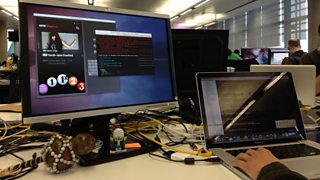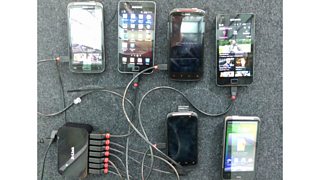Testing for ÷˜≤•¥Û–„ Online: The creation of the POD Test Group
Richard Lyon
Head of Test
Tagged with:
I’m Richard Lyon, the head of test for the recently formed Test Group within Future Media Programmes & On Demand (POD) known as ‘POD Test’.
Programme & On Demand‚Äôs output includes the product, the product, , social plugins and personalisation capabilities across mobile, tablet, desktop and TV.Ã˝
With our range of web offerings and apps and the variety of platforms we deliver them on, testing is a huge undertaking for Programmes & On Demand.

Testing elements of iPlayer Radio
Over the last few years each of the product teams within Programmes & On Demand has built up its own testing capability separately.
The test discipline both at the ÷˜≤•¥Û–„ and in the industry in general has evolved rapidly during this time from traditional testing at the end of development to extensive use of automation and the adoption of (BDD).
BDD is a software development approach with test at its core. Functionality is described by tests written with the customer. Software is then written to make those tests pass to ensure a tight and highly visible coupling between the customer‚Äôs requirements and the software that is produced.Ã˝
Test is now at the point where it is the ‘glue’ between product management, development and project management.
Tests describe how a product should behave, drives software design and describes the health and risks of a product in development.
Recently we’ve brought the separate test teams into a single POD Test group for a number of reasons:
- We wanted to ensure that innovation in test tools and processes that happen within individual test teams are leveraged across all of Programmes & On Demand to help us continue to deliver products that our audiences can rely on.
- Most of our products are built upon shared components. We want to find better ways to perform tests across this complex ecosystem and have more of a sense of collective ownership.
- We want to promote the test discipline within Programmes & On Demand so that test professionals have a clear path for development and career progression and to generally raise the profile of test.
Bringing the testers together into a single test group will allow us to address these changes more effectively.
As Programmes & On Demand is organised by product area the POD Test team will be the only discipline group within Programmes & On Demand.
That’s not to say that we’ll be adopting an agency model where we ‘hire out’ testers into the product teams, far from it.
We place high value in our testers being embedded in product teams because of the knowledge they gain about the products they work on and the pride they have in those products.
But it will allow more flexibility when we need it for testers to move into different product teams to share innovation, respond to prioritisation or if potentially they just fancy a change.
Ã˝

Testing on multiple devices
A little bit about how we test.
Although we invest heavily in automation in test we still place a lot of emphasis on manual testing.
There are some areas that can only be tested manually, particularly when it comes to video and audio quality and some defects that will only ever be uncovered by a skilled exploratory tester.
However we have seen some tremendous efficiencies achieved by automation, reducing the need for time consuming manual test cycles of repetitive checks.
There are also additional benefits we see from automated test suites such as providing ‘living documentation’. The automated tests not only document a system’s requirements but can be executed at any time to ‘check themselves’ against the system they describe to ensure the system is still meeting those requirements.
We aspire to a BDD approach where we define features in a ‘’ format. A User story is written in natural language but to a strict format that describes who a feature is for, what the feature is and what benefit that feature delivers, ( e.g. ‘As a …, I want…, so that…’).
Then representatives from the product, engineering and POD Test team come together to flesh out the behaviour of that user story by writing acceptance tests for it.
will add more detail to the user story. Like the user story they are written to a strict format that describes pre-conditions, an event and an outcome (e.g. ‘Given…, when…, then…’).
The great benefit of user stories and acceptances tests is that they provide a shared artefact that makes sense to a product owner as a description of their requirements, engineering as a specification to build to and test as a set of executable tests.
Traditionally these may have existed as three separate documents that very quickly become out of sync leading to misunderstandings and delays.
Where possible the tests are automated, either by the developers coding the feature or with the assistance of a developer-in-test.
When the tests are passing then the feature is ‘done’, whilst the automated tests build up into a regression pack allowing us to check that new features we develop aren’t breaking existing functionality.
Device testing is one of the biggest challenges we have. This means ensuring that new devices such as mobiles, , set top boxes, games consoles and other connected devices will work with our products and that new video profiles and formats and new features perform as expected across existing devices.
For mobile and connected TVs our testing can’t possibly cover all devices. Instead we have to prioritise based on stats from audience use, which tells us which are the most popular devices.
We may then categorise these further, grouping similar devices together in order to give us as broad coverage as possible.
The way we test our products never stands still. As we continue to evolve and develop our products new challenges arise about how we test them, the introduction of responsive design being a recent example.
We’ll be blogging more about how we’re tackling some of these challenges in POD Test and about how we test some of our big product launches this year, so keep checking back here and we’ll let you know how we’re getting on.
It would be great to hear your feedback, please leave a comment and tell us what you think.
Richard Lyon is the head of test for the POD Test Group.
